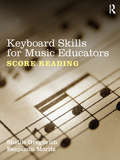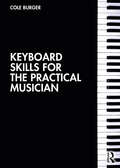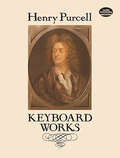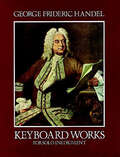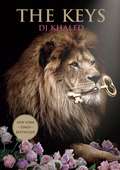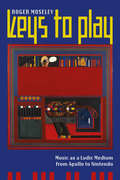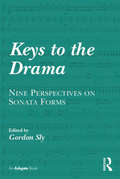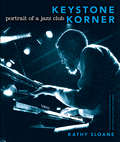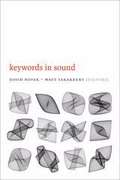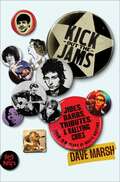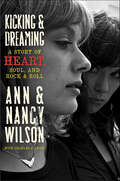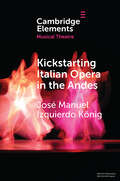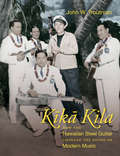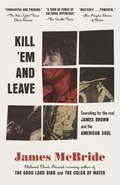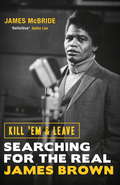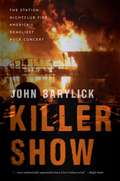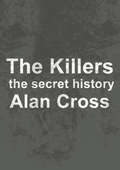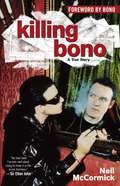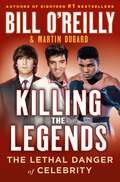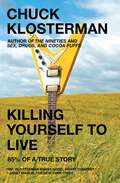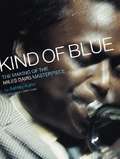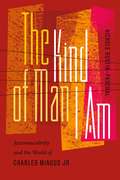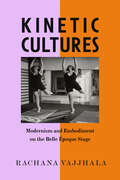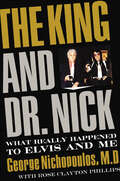- Table View
- List View
Keyboard Skills for Music Educators: Score Reading
by Shellie Gregorich Benjamin MoritzKeyboard Skills for Music Educators: Score Reading is the first textbook equip future educators with the ability to play from an open score at the keyboard. Score reading can be a daunting prospect for even the most accomplished pianist, but it is a skill required of all choral and instrumental music instructors. Although most music education curricula include requirements to achieve a certain level of proficiency in open score reading, standard textbooks contain very little material devoted to developing this skill. This textbook provides a gradual and graded approach, progressing from two-part reading to four or more parts in a variety of clefs. Each chapter focuses on one grouping of voices and provides many musical examples from a broad sampling of choral and instrumental repertoire ranging from Renaissance to contemporary works.
Keyboard Skills for the Practical Musician
by Cole BurgerKeyboard Skills for the Practical Musician provides undergraduate music majors in class piano courses with the techniques and fundamentals they need to flourish into independent, versatile musicians who play with confidence and sensitivity. Organized by skill (rather than level), the topics sequenced in this textbook offer endless flexibility for instructors while guiding students in a step-by-step approach through the development of essential keyboard skills ? such as reading, harmonization, improvisation, and accompaniment ? supporting concepts learned in music theory, ear training, private lessons, methods classes, and ensemble courses. One can draw from many sections of the book in any given class or semester, covering a wide range of piano skills that foster abilities frequently used in a myriad of musical professions.Features: • Over 400 sightreading, transposition, and score reading examples, along with 125 harmonization Melodies• Project assignments that promote independent learning, expose students to new musical styles, and encourage collaboration • A concluding Repertoire section with lists of solo and duet music, 10 ensemble arrangements, 6 duets, and additional pieces from the Baroque, Classical, Romantic, and Post-Romantic eras • Music examples include numerous works by composers from marginalized backgrounds and from global folk music• No prior piano background knowledge neededExplaining the core elements of keyboard learning in an accessible and responsive format while accentuating the importance of learning how to learn, Keyboard Skills for the Practical Musician offers an essential resource for all class piano students and instructors.
Keyboard Works
by Henry PurcellRenowned for the originality of his music and his gifts as a melodist, Henry Purcell (1659-1695) was the preeminent English composer of the seventeenth century and one of the greatest that nation has ever produced. His gifts are apparent not only in the vocal and orchestral works on which his fame rests, but in his delightful keyboard music, much of which is relatively simple and easy to perform. This volume is a near-complete collection of Purcell's keyboard compositions, including the eight suites, the core of his keyboard works. Also included are many miscellaneous one-movement pieces: airs, trumpet tunes (for harpsichord solo), grounds, preludes, dances, etc.Piano students and pianists of intermediate skills will enjoy these pieces for their charm and accessibility. Gathered here in one convenient, inexpensive volume, they offer a treasury of time-honored music that musicians and music lovers will turn to again and again.This volume has been edited with a preface by the noted music scholar William Barclay Squire.
Keyboard Works for Solo Instrument
by George Frideric HandelThe music historian Sir John Hawkings recorded that his friend Handel's keyboard improvisations "stole on the ear in a slow and solemn progression; the harmony close wrought, and as full as could be possibly be expressed; the passage concatenated with stupendous art, the whole at the same time being perfectly intelligible, and carrying the appearance of great simplicity." Such fecund spontaneity generated the few published pieces Handel wrote specifically for the keyboard. The first set of suites appeared in 1720, perhaps composed and published for the instruction of Princess Anne, to whom Handel serves as music master. Other collections of harpsichord and clavichord work followed; all seem to have been preserved from Handel's freely inventive keyboard sessions. Here, for the first time in a popularly accessible edition, are 35 of his finest keyboard works for solo instruments, reproduced from the monumental Deutsche Händelgesellschaft edition, still the most complete.This collection features the celebrated Eight Great Suites, including the Harmonious Blacksmith Air and the Passacaille in G Minor (G 255), "a work in which Handel approaches most nearly to the monumental style of his choral writing" (Grove's Dictionary). Other works include: Fugue in A Minor; Fantasia in C Major; Suite (Partita) in G Minor; Sonatina in B-flat Major; Capriccio in F Major; Minuet in G Minor; Sonatas in C Major; Chaconne in F Major; Prelude and Sonata in G Minor; and more.For this new edition, the pieces have been rearranged and retitled according to the latest scholarly sequences found in The New Grove Dictionary of Music and Musicians. Students and scholars will find many of the ideas Handel sketched here expanded and reworked in later chamber and orchestral works and in the opera dance movements; musicians and every Baroque music lover will see in these neglected pieces "a Protean fluidity" (New Grove) worthy of the great composer, and more than worthy of any musical library.
The Keys
by Dj KhaledFrom Snapchat sensation, business mogul, and recording artist DJ Khaled, the book They don't want you to read reveals his major keys to success. - Stay away from They- Don't ever play yourself- Secure the bag- Respect the code- Glorify your success- Don't deny the heat- Keep two rooms cooking at the same time - Win, win, win no matter whatFrom the Hardcover edition.
Keys to Play: Music as a Ludic Medium from Apollo to Nintendo
by Roger MoseleyAt publication date, a free ebook version of this title will be available through Luminos, University of California Press's open access publishing program for monographs. Visit www.luminosoa.org to learn more. How do keyboards make music playable? Drawing on theories of media, systems, and cultural techniques, Keys to Play spans Greek myth and contemporary Japanese digital games to chart a genealogy of musical play and its animation via improvisation, performance, and recreation. As a paradigmatic digital interface, the keyboard forms a field of play on which the book's diverse objects of inquiry--from clavichords to PCs and eighteenth-century musical dice games to the latest rhythm-action titles--enter into analogical relations. Remapping the keyboard's topography by way of Mozart and Super Mario, who head an expansive cast of historical and virtual actors, Keys to Play invites readers to unlock ludic dimensions of music that are at once old and new.
Keys to the Drama: Nine Perspectives on Sonata Forms
by Gordon SlySonata form is fundamentally a dramatic structure that creates, manipulates, and ultimately satisfies expectation. It engages its audience by inviting prediction, association, and interpretation. That sonata form was the chief vehicle of dramatic instrumental music for nearly 200 years is due to the power, the universality, and the tonal and stylistic adaptability of its conception. This book presents nine studies whose central focus is sonata form. Their diversity attests both to the manifold analytical approaches to which the form responds, and to the vast range of musical possibility within the form's exemplars. At the same time, common compositional issues, analytical methods, and overarching perspectives on the essential nature of the form weave their way through the volume. Several of the essays approach the musical structure directly as drama, casting the work as an expression of its composer's engagement with an idea or principle that is dynamic and at times intensely difficult. Others concentrate their attention on a composer's use of "motive," which typically takes the form of a simple melodic span that shapes the musical architecture through an interdependent series of structural levels. Integrating these motivic threads within the musical fabric often warrants departures from formal norms in other areas. Analyses that seek to understand works with anomalous formal qualities-whether engendered by a motivic component or not-have a prominent place in the volume. Among these, accounts of idiosyncratic tonal discourse that threatens to undermine the unfolding of form-defining qualities or events are central.
Keystone Korner, Electronic Edition: Portrait of a Jazz Club
by Kathy SloaneDuring the 1970s, when jazz clubs all over America were folding under the onslaught of rock and roll and disco, San Francisco's Keystone Korner was an oasis for jazz musicians and patrons. Tucked next to a police station in the city's North Beach area, the Keystone became known as one of the most important jazz spots in the United States. It was so beloved by musicians that superstars McCoy Tyner, Freddie Hubbard, Ron Carter, and Elvin Jones played a benefit concert just so the club could buy a liquor license. In this book, more than 100 black and white photographs, a collage of oral histories, and a marvelous CD of recordings from the club chronicle the Keystone experience.
Keywords in Sound
by David Novak Matt SakakeenyIn twenty essays on subjects such as noise, acoustics, music, and silence, Keywords in Sound presents a definitive resource for sound studies, and a compelling argument for why studying sound matters. Each contributor details their keyword's intellectual history, outlines its role in cultural, social and political discourses, and suggests possibilities for further research. Keywords in Sound charts the philosophical debates and core problems in defining, classifying and conceptualizing sound, and sets new challenges for the development of sound studies. Contributors. Andrew Eisenberg, Veit Erlmann, Patrick Feaster, Steven Feld, Daniel Fisher, Stefan Helmreich, Charles Hirschkind, Deborah Kapchan, Mara Mills, John Mowitt, David Novak, Ana Maria Ochoa Gautier, Thomas Porcello, Tom Rice, Tara Rodgers, Matt Sakakeeny, David Samuels, Mark M. Smith, Benjamin Steege, Jonathan Sterne, Amanda Weidman
Kick Out the Jams: Jibes, Barbs, Tributes, and Rallying Cries from 35 Years of Music Writing
by Dave MarshSelected writings on three decades of popular music from one of the most influential critics of his generation.Spanning three decades worth of astute, acerbic, and overall astounding music writing, Kick Out the Jams is the first large-scale anthology of the work of renowned critic Dave Marsh. Ranging from Elvis Presley to Kurt Cobain, from Nina Simone to Ani DiFranco, from the Beatles to Green Day, the book gives an opinionated, eye-opening overview of 20th century popular music—offering a portrait not just of an era but of a writer wrestling with the American empire. Every essay bears the distinct Dave Marsh attitude and voice. That passion is evident in a heart-wrenching piece on Cobain&’s suicide and legacy; a humorous attack on &“Bono&’s bullshit;&” an indignant look at James Brown and the FBI; deep, revelatory probes into the work of underappreciated artists like Patty Griffin and Alejandro Escovedo; and inspiring insight into what drives Marsh as a writer, namely &“a raging passion to explain things in the hope that others would not be trapped and to keep the way clear so that others from the trashy outskirts of barbarous America still had a place to stand—if not in the culture at large, at least in rock and roll.&” If you want to explore the recent history of pop music—its politics as well as its performers—Kick Out the Jams is the perfect guidebook.
Kicking & Dreaming: A Story of Heart, Soul, and Rock and Roll
by Ann Wilson Nancy Wilson Charles R. CrossThe story of Heart is a story of heart and soul and rock ’n’ roll. Since finding their love of music and performing as teenagers in Seattle, Washington, Ann Wilson and Nancy Wilson, have been part of the American rock music landscape. From 70s classics like “Magic Man” and “Barracuda” to chart- topping 80s ballads like “Alone,” and all the way up to 2012, when they will release their latest studio album, Fanatic, Heart has been thrilling their fans and producing hit after hit. In Kicking and Dreaming, the Wilsons recount their story as two sisters who have a shared over three decades on the stage, as songwriters, as musicians, and as the leaders of one of our most beloved rock bands. An intimate, honest, and a uniquely female take on the rock and roll life, readers of bestselling music memoirs like Life by Keith Richards and Steven Tyler’s Does the Noise in My Head Bother You? will love this quintessential music story finally told from a female perspective.
Kickstarting Italian Opera in the Andes: The 1840s and the First Opera Companies (Elements in Musical Theatre)
by José Manuel Izquierdo KönigDuring the 19th century, Italian opera became truly transatlantic and its rapid expansion is one of the most exciting new areas of study in music and the performing arts. Beyond the Atlantic coasts, opera searched for new spaces to expand its reach. This Element discusses about the Italian opera in Andean countries like Chile, Peru, Ecuador and Bolivia during the 1840s and focuses on opera as a product that both challenged and was challenged in the Andes by other forms of performing arts, behaviours, technologies, material realities, and business models.
Kika Kila: How the Hawaiian Steel Guitar Changed the Sound of Modern Music
by John W. TroutmanSince the nineteenth century, the distinct tones of k&299;k&257; kila, the Hawaiian steel guitar, have defined the island sound. Here historian and steel guitarist John W. Troutman offers the instrument's definitive history, from its discovery by a young Hawaiian royalist named Joseph Kekuku to its revolutionary influence on American and world music. During the early twentieth century, Hawaiian musicians traveled the globe, from tent shows in the Mississippi Delta, where they shaped the new sounds of country and the blues, to regal theaters and vaudeville stages in New York, Berlin, Kolkata, and beyond. In the process, Hawaiian guitarists recast the role of the guitar in modern life. But as Troutman explains, by the 1970s the instrument's embrace and adoption overseas also worked to challenge its cultural legitimacy in the eyes of a new generation of Hawaiian musicians. As a consequence, the indigenous instrument nearly disappeared in its homeland.Using rich musical and historical sources, including interviews with musicians and their descendants, Troutman provides the complete story of how this Native Hawaiian instrument transformed not only American music but the sounds of modern music throughout the world.
Kill 'Em and Leave: Searching for James Brown and the American Soul
by James McbrideNational Book Award winner James McBride goes in search of the "real" James Brown after receiving a tip that promises to uncover the man behind the myth. His surprising journey illuminates not only our understanding of this immensely troubled, misunderstood, and complicated soul genius but the ways in which our cultural heritage has been shaped by Brown's legacy. Kill 'Em and Leave is more than a book about James Brown. Brown's rough-and-tumble life, through McBride's lens, is an unsettling metaphor for American life: the tension between North and South, black and white, rich and poor. McBride's travels take him to forgotten corners of Brown's never-before-revealed history: the country town where Brown's family and thousands of others were displaced by America's largest nuclear power bomb-making facility; a South Carolina field where a long-forgotten cousin recounts, in the dead of night, a fuller history of Brown's sharecropping childhood, which until now has been a mystery. McBride seeks out the American expatriate in England who co-created the James Brown sound, visits the trusted right-hand manager who worked with Brown for forty-one years, and interviews Brown's most influential nonmusical creation, his "adopted son," the Reverend Al Sharpton. He describes the stirring visit of Michael Jackson to the Augusta, Georgia, funeral home where the King of Pop sat up all night with the body of his musical godfather, spends hours talking with Brown's first wife, and lays bare the Dickensian legal contest over James Brown's estate, a fight that has consumed careers; prevented any money from reaching the poor schoolchildren in Georgia and South Carolina, as instructed in his will; cost Brown's estate millions in legal fees; and left James Brown's body to lie for more than eight years in a gilded coffin in his daughter's yard in South Carolina. James McBride is one of the most distinctive and electric literary voices in America today, and part of the pleasure of his narrative is being in his presence, coming to understand Brown through McBride's own insights as a black musician with Southern roots. Kill 'Em and Leave is a song unearthing and celebrating James Brown's great legacy: the cultural landscape of America today. Praise for Kill 'Em and Leave"Thoughtful and probing . . . with great warmth, insight and frequent wit. The results are partisan and enthusiastic, and they helped this listener think about the work in a new way. . . . James McBride's welcome elucidation . . . is clear, deeply felt and unmistakable."--Rick Moody, The New York Times Book Review "[McBride] turns out to also be the biographer of James Brown we've all been waiting for. . . . McBride's true subject is race and poverty in a country that doesn't want to hear about it, unless compelled by a voice that demands to be heard."--Boris Kachka, New York "The definitive look at one of the greatest, most important entertainers, The Godfather, Da Number One Soul Brother, Mr. Please, Please Himself--JAMES BROWN."--Spike Lee "James McBride on James Brown is the matchup we've been waiting for, a musician who came up hard in Brooklyn with JB hooks lodged in his brain, a monster ear for the truth, and the chops to write it."--Gerri Hirshey, author of Nowhere to Run: The Story of Soul Music "An unconventional and fascinating portrait of Soul Brother No. 1 and the significance of his rise and fall in American culture."--Kirkus ReviewsFrom the Hardcover edition.
Kill 'Em and Leave: Searching for the Real James Brown
by James McBride'A formidable free-style book that isn't straight biography but a mix of history, street-level investigative reporting, hagiography, Deep South sociology, music criticism, memoir and some fiery preaching' Rolling Stone magazineA Guardian best music book of 2016The music of James Brown was almost a genre in its own right, and he was one of the biggest and most influential cultural figures of the twentieth century. But the singer known as the 'Hardest Working Man in Show Business' was also an immensely troubled, misunderstood and complicated man. Award-winning writer James McBride, himself a professional musician, has undertaken a journey of discovery in search of the 'real' James Brown, delving into the heartbreaking saga of Brown's childhood and destroyed estate, and uncovering the hidden history of Brown's early years.
Killer Show: The Station Nightclub Fire, America's Deadliest Rock Concert
by John BarylickOn February 20, 2003, the deadliest rock concert in U.S. history took place at a roadhouse called The Station in West Warwick, Rhode Island. That night, in the few minutes it takes to play a hard-rock standard, the fate of many of the unsuspecting nightclub patrons was determined with awful certainty. The blaze was ignited when pyrotechnics set off by Great White, a 1980s heavy-metal band, lit flammable polyurethane “egg crate” foam sound insulation on the club’s walls. In less than 10 minutes, 96 people were dead and 200 more were injured, many catastrophically. The final death toll topped out, three months later, at the eerily unlikely round number of 100. The story of the fire, its causes, and its legal and human aftermath is one of lives put at risk by petty economic decisions―by a band, club owners, promoters, building inspectors, and product manufacturers. Any one of those decisions, made differently, might have averted the tragedy. Together, however, they reached a fatal critical mass. Killer Show is the first comprehensive exploration of the chain of events leading up to the fire, the conflagration itself, and the painstaking search for evidence to hold the guilty to account and obtain justice for the victims. Anyone who has entered an entertainment venue and wondered, “Could I get out of here in a hurry?” will identify with concertgoers at The Station. Fans of disaster nonfiction and forensic thrillers will find ample elements of both genres in Killer Show.
The Killers: The Secret History (The\secret History Of Rock Ser.)
by Alan CrossAlan Cross is the preeminent chronicler of popular music.Here he provides a history of Las Vegas rock band The Killers.This look at "one of the biggest new bands of the new century" is adapted from the audiobook.
Killing Bono
by Neil MccormickSome are born great. Some achieve greatness. Some have greatness thrust upon them. And some have the misfortune to go to school with Bono. Everyone wants to be famous. But as a young punk in Dublin in the 1970s, Neil McCormick's ambitions went way beyond mere pop stardom. It was his destiny to be a veritable Rock God. He had it all worked out: the albums, the concerts, the quest for world peace. There was only one thing he hadn't counted on. The boy sitting on the other side of the classroom had plans of his own. Killing Bono is a story of divergent lives. As Bono and his band U2 ascended to global superstardom, his school friend Neil scorched a burning path in quite the opposite direction. Bad drugs, weird sex, bizarre haircuts: Neil experienced it all in his elusive quest for fame. But sometimes it is life's losers who have the most interesting tales to tell. Featuring guest appearances by the Pope, Bob Dylan, and a galaxy of stars, Killing Bono offers an extremely funny, startlingly candid, and strangely moving account of a life lived in the shadows of superstardom. "The problem with knowing you is that you've done everything I ever wanted to," Neil once complained to his famous friend. "I'm your doppelganger," Bono replied. "If you want your life back, you'll have to kill me." Now there was a thought...
Killing the Legends: The Lethal Danger of Celebrity (Killing series #12)
by Bill O'Reilly Martin DugardIn the next book in the multimillion-selling Killing Series, Bill O'Reilly and Martin Dugard tell the larger-than-life stories of Elvis Presley, John Lennon, and Muhammad Ali.The King is dead. The Walrus is shot. The Greatest is no more.Elvis Presley, John Lennon, and Muhammad Ali. These three icons changed not only the worlds of music, film, and sports, but the world itself. Their faces were known everywhere, in every nation, across every culture. And their stories became larger than life—until their lives spun out of control at the hands of those they most trusted.In Killing the Legends, Bill O’Reilly and Martin Dugard explore the lives, legacies, and tragic deaths of three of the most famous people of the 20th century. Each experienced immense success, then failures that forced them to change; each faced the challenge of growing old in fields that privilege youth; and finally, each became isolated, cocooned by wealth but vulnerable to the demands of those in their innermost circles. Dramatic, insightful, and immensely entertaining, Killing the Legends is the twelfth book in O’Reilly and Dugard’s Killing series: the most popular series of narrative history books in the world, with more than 18 million copies in print.
Killing Yourself to Live: 85% of a True Story
by Chuck KlostermanBuilding on the national bestselling success of Sex, Drugs, and Cocoa Puffs, preeminent pop culture writer Chuck Klosterman unleashes his best book yet--the story of his cross-country tour of sites where rock stars have died and his search for love, excitement, and the meaning of death.For 6,557 miles, Chuck Klosterman thought about dying. He drove a rental car from New York to Rhode Island to Georgia to Mississippi to Iowa to Minneapolis to Fargo to Seattle, and he chased death and rock 'n' roll all the way. Within the span of twenty-one days, Chuck had three relationships end--one by choice, one by chance, and one by exhaustion. He snorted cocaine in a graveyard. He walked a half-mile through a bean field. A man in Dickinson, North Dakota, explained to him why we have fewer windmills than we used to. He listened to the KISS solo albums and the Rod Stewart box set. At one point, poisonous snakes became involved. The road is hard. From the Chelsea Hotel to the swampland where Lynyrd Skynyrd's plane went down to the site where Kurt Cobain blew his head off, Chuck explored every brand of rock star demise. He wanted to know why the greatest career move any musician can make is to stop breathing...and what this means for the rest of us.
Kind of Blue: The Making of the Miles Davis Masterpiece
by Ashley Kahn Jimmy CobbAn account of the creation, recording, and selling of Kind of Blue, a jazz classic. Many photos are described and have captions.
The Kind of Man I Am: Jazzmasculinity and the World of Charles Mingus Jr. (Music-culture Ser.)
by Nichole Rustin-PaschalNearly four decades after his death, Charles Mingus Jr. remains one of the least understood and most recognized jazz composers and musicians of our time. Mingus’s ideas about music, racial identity, and masculinity—as well as those of other individuals in his circle, like Celia Mingus, Hazel Scott, and Joni Mitchell—challenged jazz itself as a model of freedom, inclusion, creativity, and emotional expressivity. Drawing on archival records, published memoirs, and previously conducted interviews, The Kind of Man I Am uses Mingus as a lens through which to craft a gendered cultural history of postwar jazz culture. This book challenges the persisting narrative of Mingus as jazz’s “Angry Man” by examining the ways the language of emotion has been used in jazz as shorthand for competing ideas about masculinity, authenticity, performance, and authority.
Kindergarten Kids: Riddles, Rebuses, Wiggles, Giggles, And More! (Into Reading, Read Aloud #Module 1, Book 3)
by Stephanie Calmenson Melissa SweetNIMAC-sourced textbook
Kinetic Cultures: Modernism and Embodiment on the Belle Epoque Stage (California Studies in 20th-Century Music #32)
by Rachana VajjhalaBelle époque Paris adored dance. Whether at the music hall or in more refined theaters, audiences flocked to see the spectacles offered to them by the likes of Isadora Duncan, Diaghilev’s flashy company, and an embarrassment of Salomés. After languishing in the shadow of opera for much of the nineteenth century, ballet found itself part of this lively kinetic constellation. In Kinetic Cultures, Rachana Vajjhala argues that far from being mere delectation, ballet was implicated in the larger republican project of national rehabilitation through a rehabilitation of its citizens. By tracing the various gestural complexes of the period—bodybuilding routines, appropriate physical comportment for women, choreographic vocabularies, and more–-Vajjhala presents a new way of understanding histories of dance and music, one that she locates in gesture and movement.
The King and Dr. Nick: What Really Happened to Elvis and Me
by George Nichopoulos Rose Clayton PhillipsThe truth about Elvis’s death from the doctor who spent eleven years as “the King’s” personal physician, father-figure, and confidant - "Dr. Nick."Dr. Nichopoulos spent a decade with Elvis on the road and at Graceland, trying to maintain the precarious health of one of the world’s greatest entertainers. But on August 16, 1977, he found himself in the ambulance with Elvis on that fateful last trip to the ER. He signed the death certificate.From that day forward, Dr. Nick became the focus of a media witch hunt that threatened his life and all but destroyed his professional reputation. Now, for the first time, Dr. Nick reveals the true story behind Elvis’s drug use and final days—not the version formed by years of tabloid journalism and gross speculation. Put aside what you’ve learned about Elvis’s final days and get ready to understand for the first time the inner workings of “the king of rock n’ roll.”
